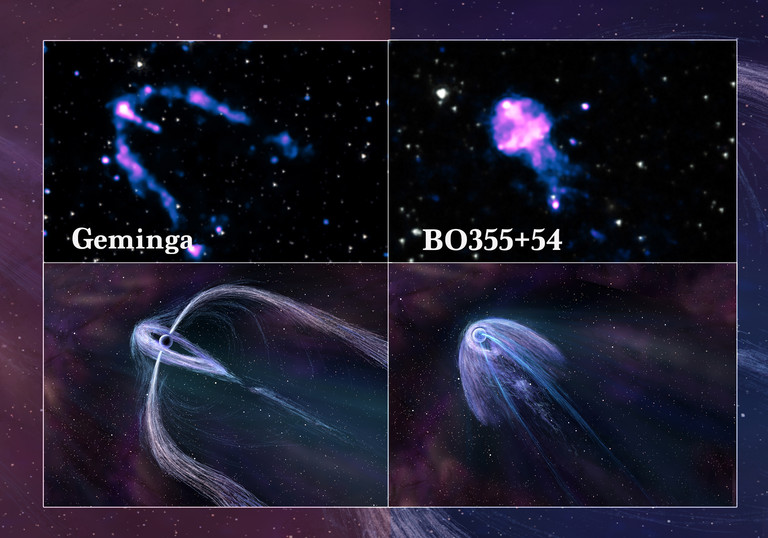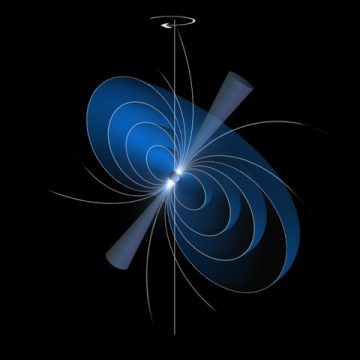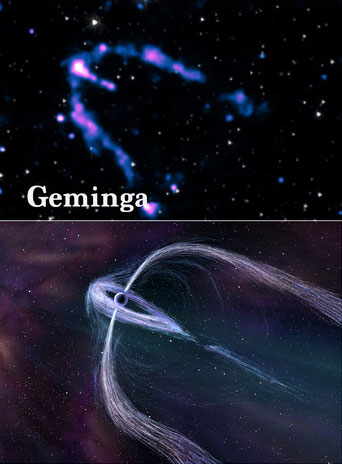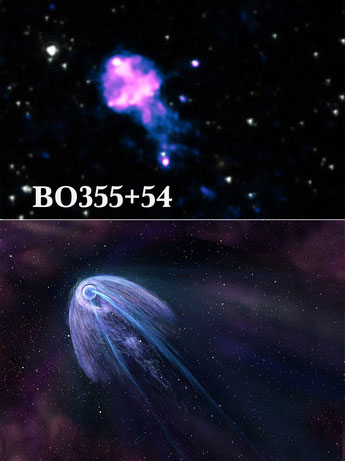New images of two pulsars show beautiful, complex clouds of charged particles that illustrate the power dynamics in and around these spinning neutron stars.

Geminga X-ray image: NASA / CXC / PSU / B.Posselt et al.; B0355+54 X-ray image: NASA / CXC / GWU / N.Klinger et al; Infrared background images: NASA / JPL-Caltech; Illustrations (bottom): Nahks Tr'Ehnl
When a star goes supernova, it leaves behind a crushed stellar remnant that endures long after the expanding layers of gas from the stars’ outer layers disperse. But far from sitting in still repose, these remnants, often pulsars, whiz through space, kicked away in the supernova explosion. The complex and beautiful particle clouds they generate as they travel help astronomers learn about the physics that powers them.
Two independent groups of astronomers studied two very different pulsars, Geminga and B0355+54, both of which are surrounded by clouds of X-ray-emitting particles (called pulsar wind nebulae). The teams observed these pulsar-produced clouds using long exposures with the space-based Chandra X-ray Observatory. The observations have enabled the teams to paint a picture of the pulsars’ configurations and physics.
What Is a Pulsar and What Is a Pulsar Wind Nebula?

ESA / ATG medialab
Jocelyn Bell discovered the first pulsar in the late 1960s by its pulsing radio waves. Those short, bright beats came from a rotating neutron star, aka a pulsar. If the pulsar's beam crosses our line of sight, we see its signal, like a strobe from a lighthouse. By watching these pulses over time, astronomers can determine the pulsar’s spin rate, the strength of its magnetic field, and its age.
Though a pulsar’s beat is its most defining characteristic, it’s not all we see. Huge electric forces, generated by the spinning magnetic field, rip charged particles off the surface of the pulsar. Some of these particles escape as jets from the poles. Others form a donut-shaped cloud around the pulsar, which sweeps around as the pulsar rotates.
In both cases, these particles are energetic enough to produce emission across the electromagnetic spectrum. And as pulsars travel through the dust and gas between stars, the billows of charged particles interact with the interstellar medium, which sweeps the clouds into a variety of dramatic shapes.
Astronomers often sort out pulsars' emissions on a case-by-case basis, but in doing so, they've found that even pulsars that seem like opposites may be more similar than they first appear: the differences might come about depending on the line of sight into their complicated geometries. A particular viewing angle gives a distinct glimpse at the pulsar's velocity through space, its spin axis, and its magnetic field axis (the two axes aren't typically aligned). In many pulsar models, for example, the magnetic poles emit radio waves, while gamma rays typically come from a broader region that’s closer to the equator, so what you see depends on the angle you're viewing.
This leads back to Geminga and B0355+54, a pair of opposite pulsars: Geminga pulses in gamma rays but is quiet in the radio, while B0355+54 pulses in radio waves but not in gamma rays. However, both pulsars produce X-ray-emitting particle winds, whose features shed light on the objects' differing geometries.
Geminga

X-ray: NASA / CXC / PSU / B.Posselt et al.; Illustration: Nahks TrEhnl
Bettina Posselt (Penn State University) and colleagues observed Geminga for 6.7 days over an 8-month time period, exposing the pulsar wind nebula around one of the closest gamma-ray pulsars. It features a distinct bow-shaped shock front, formed as the pulsar ploughs through the interstellar medium, as well as a ring around the pulsar and three tails.
As the pulsar speeds through space, the interstellar medium sweeps back the two longer tails that surround the pulsar. These tails may form as jets of particles shoot out along the poles of the pulsar, which we see spinning edge-on to our line of sight. However, this configuration implies that the spin axis is nearly perpendicular to the pulsar's velocity. Such alignment would be unusual, unless perhaps Geminga had a companion star before it went supernova.
While prior observations hadn’t been able to pin down the geometry of the pulsar, the sharper Chandra images also enable astronomers to pick out the finer details. The images show distinct, flickering blobs in the shorter tail that trails the pulsar. The blobbiness suggests that the particles aren't shooting out in a jet — if they were, the tail would show a more constant stream. Posselt and colleagues suggest the blobs might instead come from the torus around the pulsar. Or, they offer, the blobs could form during magnetic reconnection, when magnetic field lines cross and rearrange themselves, shooting out gas that was trapped along the field lines.
B0355+54

X-ray: NASA / CXC / GWU / N.Klinger et al.; Illustration: Nahks Tr'Ehnl
Noel Klingler (George Washington University) and colleagues observed B0355+54 for a total of 4.6 days. This pulsar shows a bright cloud of particles surrounding the pulsar. A dim tail and still dimmer “whiskers” extend to either side. This shape suggests we’re looking at the pole of the spinning pulsar — an orientation that explains why we don’t see gamma-ray pulses, which should come from closer to the pulsar’s equator.
The dim tail spans more than 6 light-years, a larger distance than from the Sun to our closest stellar neighbor, Proxima Centauri. The “whiskers” are approximately perpendicular to the pulsar’s direction of motion. Klinger’s team suggests that high-energy particles might leak from the pulsar wind nebula’s magnetic field to create these whiskers.
These studies of the pulsar wind nebulae surrounding Geminga and B0355+54 reveal differences in alignment that affect what we see, including the presence (or absence) of gamma-ray and radio pulses. Extended observations of pulsars’ X-ray emission are helping astronomers to to produce detailed scenarios that describe the complex geometry and physics of pulsars.
References:
Klingler et al. “Deep Chandra Observations of the Pulsar Wind Nebula Created by PSR B0355+54.” The Astrophysical Journal, 2016 December 20.
Posselt et al. “Geminga's Puzzling Pulsar Wind Nebula.” The Astrophysical Journal, 2017 January 20.
 1
1









Comments
Anthony Barreiro
February 8, 2017 at 4:35 pm
Thanks, this is very vivid and helps me understand these pulsars more clearly.
Since I'm a humble skywatcher, I always like to know where something is in the sky and how far away it is, so I did a little research. Geminga, not surprisingly, is between the feet of Pollux and Castor in Gemini. Apparently the name is a contraction of "Gemini gamma ray source". It's 815 light years away. B0355+54 looks to be in northeastern Perseus, and much further away at 3400 light years. It doesn't seem that either could be seen in visible light, but it will still be fun to look up and imagine those pulsars flying through our galaxy, trailing plumes of particles and glowing in radio or gamma rays, as well as x-rays.
You must be logged in to post a comment.
You must be logged in to post a comment.